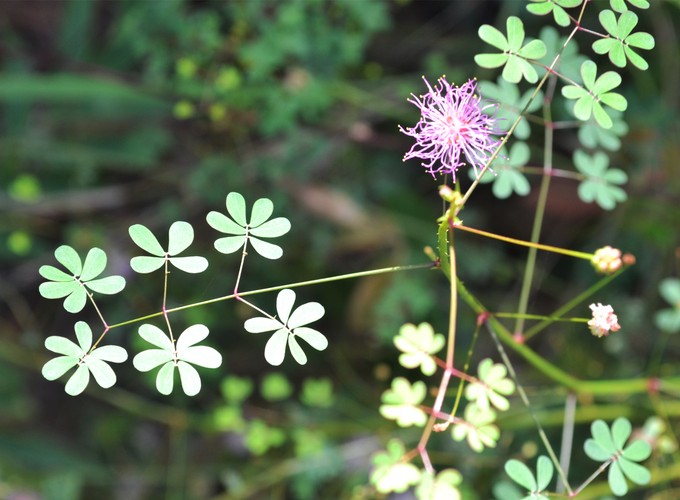- Mimosa is a megadiverse neotropical genus, with more than 550 species, and ca. 40 species in Old World, but several species became pantropical.
See the post showing the distribution of Mimosa using the
LeafletR package (Cheng et al. 2018).
Mimosa L. belongs to clade Mimosoid, within the family Leguminosae (LPWG 2017).
The last taxonomic revision of the genus was performed by Barneby (1991).
Diagnostic characters of sections, according Barneby (1991):
Sect. Mimadenia
Sect. Batocaulon
Sect. Calothamnos
Sect. Habbasia
Sect. Mimosa
The most comprehensive phylogenetic study of Mimosa proved its monophyletic status (Simon et al. 2011).

Sect. Mimadenia is the only monophyletic section in the genus, according Barneby’s (1991) infrageneric classification.
A new classification based on phylogenetic studies is expected for the genus.
Mimosa is characterized by its bipinnate and paripinnate leaves, capitate or spicate inflorescence, 3–6-merous flowers, iso- or diplostemonous, and craspedium fruit, with articulated or non-articulated epicarp, and differs from other similar mimosoids by the 6-12 stamens and absence of glands on the anthers (Barneby 1991; Barroso et al. 1999).
- Bipinnate and paripinnate leaf

Leaf of M. diplotricha
- Bipinnate and paripinnate leaf
Mimosa is especially distinguished by two peculiar leaf structures:
Paraphyllidia
- Pair of leaf-like projections developed between the pinna-pulvinus and the first pair of leaflets
- often present
- form/shape: often linear, lanceolate, short-triangular (or conic), or oval with acute apex

Short-triangular (or conic) paraphyllidia of M. bimucronata 
Lanceolate paraphyllidia of M. monticola, unequal in size
Spicule
- Projection developed at the interpinnal space on abaxial face of leaf-rachis
- present or absent
- form/shape: short-triangular (or conic), linear-subulate, or spiniform

short-triangular (or conic) spicule of M. arenosa

Linear-subulate spicule of M. diplotricha

Spiniform spicule of M. pigra
The presence of leaf-nectaries is rare in the genus
- Only present in M. sect. Mimadenia Barneby
- Composed by only 16 species
- Sister group of all other Mimosa groups (Simon et al. 2011)
- The presence of leaf-nectaries is also reported in outgroups (of Piptadenia group). Hence, their presence in Mimosa is a plesiomorphic trait

Leaf-nectary of M. extensa
Recognize different types of trichomes is very important for species identification
The main types of trichomes are:
Filiform
- Simple (not-branched), uniseriate

Abaxial surface leaflet of M. cubatanensis with filiform trichomes denser at the base 
Rachilla of M. arenosa sparsely covered with filiform trichomes
- Simple (not-branched), uniseriate
Setiform
- Simple (not-branched, but sometimes with minute projections), multiseriate

Abaxial surface leaflet of M. sensitiva showing both filiform (smaller) and setiform (bigger) trichomes 
Abaxial surface leaflet of M. pigra with setiform trichomes with minute projections 
Stipule of M. elliptica with setiform trichomes with dilated base
- Simple (not-branched, but sometimes with minute projections), multiseriate
Stellate
- Multiangulate branched, sessile, subsessile, or stalked, peduncle multiseriate

Stellate-subsessile or -sessile trichomes of M. schomburgkii 
Stellate-stalked trichomes of M. schomburgkii
- Multiangulate branched, sessile, subsessile, or stalked, peduncle multiseriate
Dendritic
- Multiseriate axis, densely branched

Dendritic trichomes of M. pilulifera var. pseudincana
- Multiseriate axis, densely branched
Glandular
- Subsessile or stalked

Glandular-subsessile trichomes of M. paludosa 
Glandular-stalked trichomes of M. paludosa
- Subsessile or stalked
Inflorescence types
Capitate

Spicate

Flower morphology is one of the most important diagnostic character
Merosity
Most species is tetramerous, but others are trimerous, pentamerous, and, rarely, hexamerous

Tetramerous flower of M. bimucronata Trimery is a rare condition, and evolved independently at least six times in the genus (Simon et al. 2011)
Mostly are natural from the Brazilian Caatinga

Trimerous flower of M. caesalpiniifolia
Calyx
Campanulate

Campanulate calyx of M. elliptica Pappiform (term used by Barneby 1991 in allusion to the pappiform calyx of Asteraceae)

Pappiform calyx of M. pigra
Number of stamens

Diplostemonous
- Plesiomorphic trait
- Sect. Mimadenia, Batocaulon (few exceptions) and Habbasia
Isostemonous
- Apomorphic trait
- Sect. Calothamnos and Mimosa
Color of stamens
Whitish
- Many
- Many
Pinkish
- Many
- Many
Purplish
- Many
- Many
Yellowish
- Sect. Calothamnos (see M. furfuracea)
- Sect. Calothamnos (see M. furfuracea)
Reddish
Fruit type
- Craspedium, a type of legume with a persistent margin (replum) and which its epicarp is, generally, divided into monospermic and caducous articles (articulated) or the entire epicarp is divided into two caducous valves (non-articulated)

Craspedium with articulated epicarp of M. campicola 
Craspedium with non-articulated epicarp of M. ceratonia











